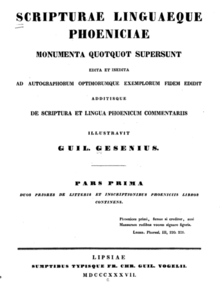Scripturae Linguaeque Phoeniciae
 Cover of part one (Pars Prima) | |
| Author | Wilhelm Gesenius |
|---|---|
| Language | Latin |
| Genre | Phoenician language |
Publication date | 1837 |
| Publication place | Leipzig |
Scripturae Linguaeque Phoeniciae (in English: "The writing and language of Phoenicia"), also known as Phoeniciae Monumenta (in English: "Phoenician remains") was an important study of the Phoenician language by German scholar Wilhelm Gesenius. It was written in three volumes, combined in later editions.[1] It was described by Reinhard Lehmann as "a historical milestone of Phoenician epigraphy".[2]
It published all c.80 inscriptions and c.60 coins known in the entire Phoenicio-Punic corpus at the time.[3]
Contents
- Full Title: The writing and language of all the surviving Phoenician remains, published and unpublished copies of the best examples, illustrated and explained by Wilhelm Gesenius.
- First part: Containing the first two books on Phoenician letters and inscriptions [p. i–xxviii, 1–260], therein:
- First book: containing Phoenician palaeography [p. 1–89]
- Second book: illustrating the Phoenician inscriptions [p. 90–260]
- Second part: Containing two later books on the gods and the language of the Phoenicians [p. 261–482], therein:
- Third book: On the Phoenician gods [p. 261–328]
- Fourth book: Illustrating the Phoenician language [p. 329–482]
- Third part: containing forty-six inscribed stone tablets [Tab. 1–48 (sic)]
List of inscriptions
| Gesenius (1837) | Hamaker (1828) | CIS (1880s) | KAI (1960s) | Other | |
|---|---|---|---|---|---|
| Cippi of Melqart | 1 | I 122 | 47 | ||
| Benhisa inscription | 2 | I 124 | - | ||
| Mdina steles | 3-4 | III 1-2 | I 123 | 61 | |
| Athenian Greek-Phoenician inscriptions | 5-7 | I 116, 117, 120 | 53, 55 | ||
| Pococke Kition inscriptions | 8-40 | IV | I 11, 46, 57-85 | 33, 35 | |
| Nora Stone | 41 | I 144 | 46 | ||
| Carthaginian | 46-55, 81-83 | I 1-3 | |||
| Punic-Libyan bilinguals | 56 | II 3 | 100 | ||
| Numidia | 57-63, 84 | II 1-2 | |||
| Tripolitania Punic inscriptions | 64-65 | III 4-5 | IPT 9-10 | ||
| Gems and stamps | 67-70 | II 79, 81 | |||
| Non-Phoenician: | |||||
| Carpentras Stela | 71 | II 141 | |||
| Stela Saltiana[4] | 72 | II 143 | TAD D22.54 | ||
| Turin Aramaic Papyrus | 73 | III 3 | II 144 | ||
| Blacas papyri | 74-75 | II 145 | TAD C1.2 | ||
| Pseudo-Phoenician or forgeries: | |||||
| [Other] | 76-80 | II 54 | |||
Editions
- Gesenius, F.H.W. (1837). Scripturae linguaeque phoeniciae monumenta quotquot supersunt edita et inedita ad autographorum optimorumque exemplorum fidem edidit additisque de scriptura et lingua Phoenicum commentariis illustravit Guil. Gesenius: Duos priores de litteris et inscriptionibus phoeniciis libros continens. 1 (in Latin). Vol. 1. sumptibus typisque Fr. Chr. Guil. Vogelii.
- Scripturae linguaeque phoeniciae (in Latin). Vol. 2. 1837.
- Scripturae linguaeque phoeniciae (in Latin). Vol. 3. 1837.
References
- ^ Lehmann 2013, p. 240: "Basically, its core consists of the comprehensive edition, or re-edition of 70 Phoenician and some more non-Phoenician inscriptions... However, just to note the advances made in the nineteenth century, it is noteworthy that Gesenius' precursor Hamaker, in his Miscellanea Phoenicia of 1828, had only 13 inscriptions at his disposal. On the other hand only 30 years later the amount of Phoenician inscribed monuments had grown so enormously that Schröder in his compendium Die phönizische Sprache. Entwurf einer Grammatik nebst Sprach- und Schriftproben of 1869 could state that Gesenius knew only a quarter of the material Schröder had at hand himself."
- ^ Lehmann 2013, p. 238.
- ^ Foreign Quarterly Review 1838, p. 245: "What is left consists of a few inscriptions and coins, found principally not where we should a priori anticipate, namely, at the chief cities themselves, but at their distant colonies... even now there are not altogether more than about eighty inscriptions and sixty coins, and those moreover scattered through the different museums of Europe."
- ^ Society of Biblical Archæology (London, England) (1878). Proceedings. Getty Research Institute. London. p. 34.
Bibliography
- Foreign Quarterly Review (1838). Review of Wilhelm Gesenius's publications. L. Scott.
- Lehmann, Reinhard G. [in German] (2013). "Wilhelm Gesenius and the Rise of Phoenician Philology" (PDF). Beihefte zur Zeitschrift für die alttestamentliche Wissenschaft. 427. Berlin / Boston: De Gruyter. Archived from the original (PDF) on 2016-03-04.
- Hamaker, Hendrik Arent (1828). Miscellanea Phoenicia, sive Commentarii de rebus Phoenicum, quibus inscriptiones multae lapidum ac nummorum, nominaque propria hominum et locorum explicantur, item Punicae gentis lingua et religiones passim illustrantur. S. et J. Luchtmans.
- CIS: Corpus Inscriptionum Semiticarum
- KAI: Kanaanäische und Aramäische Inschriften
